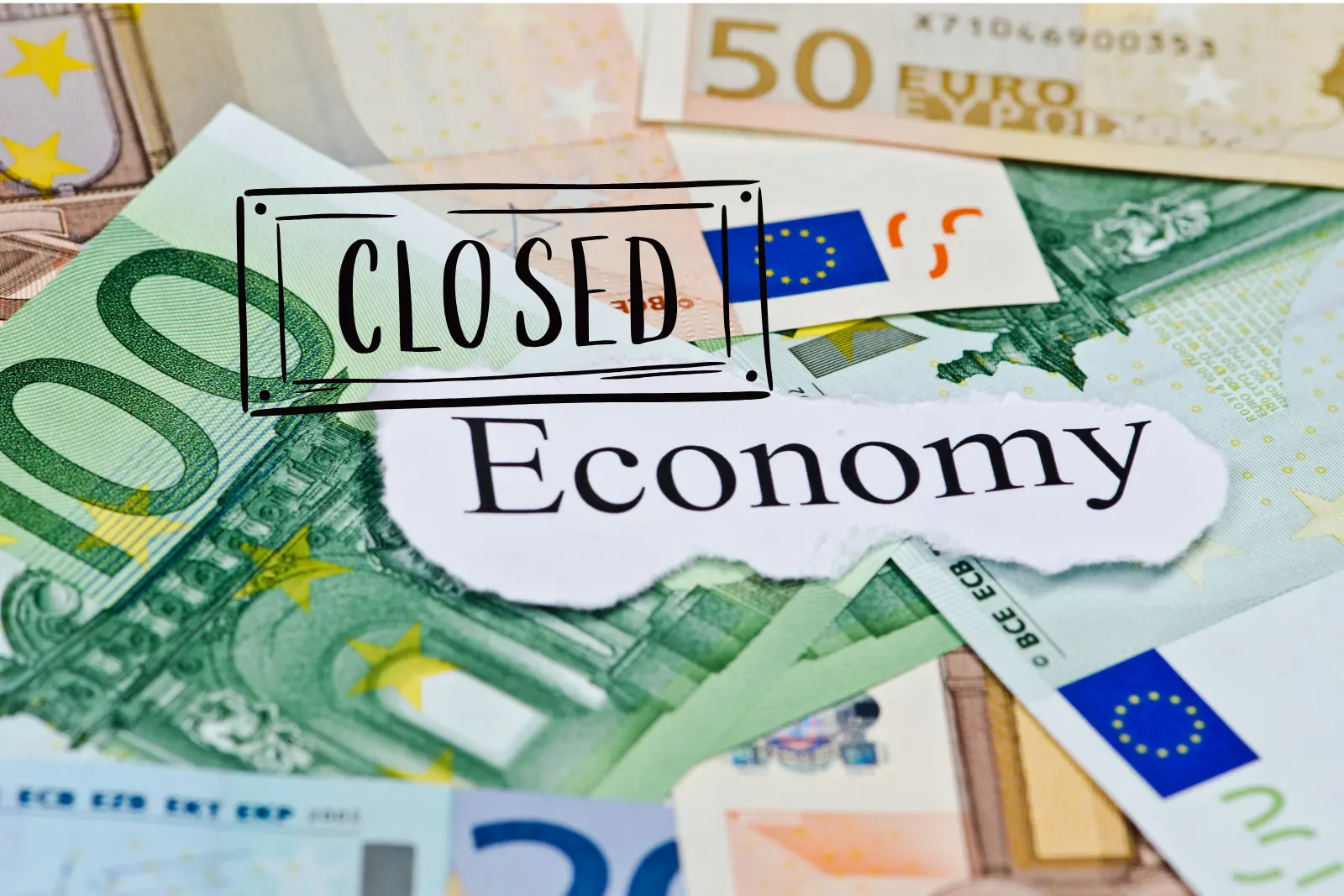The majority of people aren’t aware of the severe restrictions that governments can put in place in a closed economy. They typically consist of the imposition of trade barriers and import restrictions, and strict rules on foreign investment. All this is done in the hope of creating an economic self-sufficient society. As a business owner or consumer, you’ll see that these limitations directly impact your access to goods. The pricing and market conditions will also get imapcted. This blog focuses on these restrictions by the government and the implications on your business and behavior in a closed market.
Overview of a Closed Economy
Many people are apprehensive about the notion of a closed economy could bring up thoughts of self-sufficiency or economic isolation. Closed economies limit their interactions with the world outside by focusing on only domestic consumption. The production will be limited which affects the international flow of trade and investment. Understanding the way in which this system works is essential to understanding the ways in which government restrictions could significantly affect consumers and businesses alike.
Definition and Characteristics
In addition to the emphasis on domestic economic activity, Closed economies are defined by a lack of or minimal involvement with international trade, strict restrictions on exports and imports, as well as a dependence on local sources of production and consumption. The majority of governments implement policies to control economic activity within their borders, which affect diverse sectors ranging from agriculture to manufacturing.
Historical Context
Alongside contemporary examples such as North Korea, closed economies have been seen throughout the past, particularly in times of economic instability or conflict. Countries have employed closed economies as a safeguard measure to protect their industries from competition from abroad in order to promote stability and growth in their own economies.
Therefore, closed systems typically emerged due to historical events like those of the Great Depression, where countries moved inward to help local economies. Through limiting trade, governments sought to protect jobs and manage important industries. However, the long-term consequences generally included stagnation and a lack of technological progress, which highlighted the difficulty of balancing protectionist policies and economic growth.
Government Restrictions in a Closed Economy
A closed economy may give a sense of stability, it can also lead the government to place restrictions in order to minimize the influence of external economic forces. These restrictions aim to safeguard the domestic industry and ensure self-sufficiency. However, they can affect your business and your consumer choices. Through the control of trade and regulatory issues, the government can shape the economy in which you work.
Trade Barriers and Tariffs
For many companies operating that operate in a closed market tariffs and trade barriers are typically used to stop imports and help protect local industries. These measures can result in more expensive imports and can affect your business’s competitiveness in pricing and strategies for eventually influencing the way consumers behave.
Regulatory Measures
In a closed economy, measures usually require strict rules on pricing, production, and the distribution of goods within the market in which you are. The policies of regulation will be enforced in order to make sure local businesses adhere to certain standards, which can impact your ability to operate and market dynamic.
Additionally, these rules could include licensing specifications, quality control requirements, and limitations on foreign ownership. All of these directly impact your company’s ability to develop and compete. Through these measures the government is trying to regulate the market, while also encouraging domestic growth. This could hinder your access to the latest technologies and the most effective practices. However, it potentially limits your success over the long term.
Impact on Businesses
One of the major effects of an economy that is closed is the limitations it imposes on companies, which limits their potential to function within a global marketplace. With restrictions on trade and rules in place, businesses are faced with difficulties in gaining access to foreign markets and battling international competitors, which could hinder innovation, growth, and efficiency of their operations.
Domestic Production and Market Restrictions
Before the closed-economy policies are put into place it is crucial to realize that your company will primarily dependent upon domestic consumption and production. This can result in an absence of variety in the products available to consumers. This can increase the dependence of local sources, which can impact the supply chain overall and causing price increases due to lower competition.
Innovation and Competitiveness Challenges
When you establish an economy that is closed, your business may face difficulty to stay competitive and innovative. In the absence of foreign competition, it can lead to complacency within local industries, which can lead to stagnant product development, and less incentive to boost efficiency or embrace the latest technology. In the end, you could have less appeal on the market and be disadvantaged in the ever-growing globalization.
Techniques for production could become obsolete with no influence from international standards and developments. In a closed market the ability to innovate can be hindered due to the fact that a lack of access technology from abroad hinders your business from increasing productivity and meeting the expectations of customers. The absence of competition could mean that your company will be unable to take advantage of opportunities to diversify your product line and enhance quality, eventually diminishing your market share over the long term.
Impact on Consumers
In contrast to an open economy closed economies can dramatically change your purchasing power as well as life. Because of restrictions on trade, you could have limited access to a variety of items and services that could significantly impact your level of living. Lack of competition from abroad is often a cause of stagnant market dynamics that result in less options and reduced capacity to innovate on the market.
Limited Choices and Higher Prices
At the heart of a closed economy is the effect on market access. When domestic industries are protected against foreign competitors, your options are restricted, leading to higher prices because of less competition. There is a lack of alternatives, which leaves consumers with no better options to choose from. This restriction could have an impact on your budget for the household and force you to spend more on similar or lower quality products.
Quality and Availability of Goods
For further illustration an example, a closed-down economy generally has difficulty maintaining high-quality products and their availability. A lack of engagement with international markets limits access to new products and advanced technologies that can improve the choice of consumers. Therefore, you could be faced with shortages of popular products and you’ll have to use local options.
Furthermore, when businesses are not competing with other businesses, the desire for top quality may diminish as the absence of competition globally reduces the motivation for improvement. This could result in an environment where goods may not be able to meet the changing requirements and preferences you want. This stale environment hampers technological advancements that typically result from exposure to international concepts and practices. This ultimately affects the quality and quantity of products you can choose from as a buyer.
Economic Self-Sufficiency is different from Dependency
Many see an economy that is closed as a path to economic self-sufficiency. By restricting trade with foreign countries as well as encouraging domestic production, with the goal of helping satisfy the nation’s demands on its own. This strategy will help stabilize the economy, reducing dependence of external markets, and thus protecting the economy from international fluctuations. But, attaining this self-reliance may require significant compromises for both consumers and businesses.
Benefits of Self-Reliance
Self-sufficiency in a closed market can help you safeguard your local industries and encourage local jobs. By focusing on locally-produced goods, you will encourage innovation and keep the economic benefits that are generated within your own borders, making a more resilient economy, while also ensuring prices and market stability.
Risks of Isolation
When you establish a closed economy, there are risks of solitary nature. Although self-reliance may be beneficial however, it usually leads to restricted access to markets around the world. As time passes, this detachment could slow down technology and innovation and slow down economic growth overall.
In the absence of competition, it can cause inefficiencies in manufacturing processes. This may cause the domestic industries not feel the pressure to innovate or improve. Furthermore, the dependence on domestic resources can result in the absence of consumer choice and shortages. That can impede economic growth. In the long term the risks of being isolated could adversely impact consumers and businesses as well. That is the reason an equilibrium between self-sufficiency as well as global participation is crucial for sustaining economic growth in a closed market.
Case Studies
To comprehend the effect of a closed economy, it is helpful to study different case studies. That show the ways that government regulations can affect the business environment. Here are a few case studies that show these dynamics:
- North Korea: Approximately 85 percent of the economy is controlled by the government, with little foreign trade, which leads to food shortages that affect more than 40 percent of the people.
- Cuba After 1960, trade between Cuba and Cuba with the U.S. dramatically decreased, leading to a decrease in GDP by 35% from 1989 until 1993.
- India (1960-1991) A stringent system of import licenses and trade restrictions restricted growth, and an average annual GDP increase of just to 4 percent.
Examples of Closed Economies
In examining the present world there are some countries operating with closed-economy principles or have restricted their economic interaction with the world. North Korea stands out as one of the most prominent examples, with strict restrictions on investment and trade and investments. Cuba has faced severe economic restrictions because of decades trading restrictions especially in relation to the U.S.
Lessons Learned
The study of closed economies can provide an insightful insight into the effect of government restrictions. One of the most important lessons is the necessity of balancing self-sufficiency and international involvement to prevent detrimental economic inefficiencies.
Study of closed economies such as North Korea and Cuba illustrate the risks associated with isolationism. While protectionist policies can provide some short-term benefits. They can create long-term economic difficulties that include a lack of growth and stagnation in markets. A resilient economy is build with healthy balance between the production of domestic goods and trade with international partners. Such economy focuses on growth and adaptability for both consumers and businesses.
Conclusion
From the above discussion in the blog, it is evident that in a closed-system economy government enforces restrictions. These restrictions includs the import quota system, tariffs as well as strict regulations to control trade and ensure self-sufficiency. These restrictions can pose challenges for the business owner. Because they restrict access to markets and cutting down on competition, which could result in more expensive costs for consumers. In turn, your company could have less growth opportunities and consumers will have limited choices and more expensive cost. Understanding these dynamics is crucial to navigate the complexity of a closed economy successfully.
Frequently Asked Questions (FAQs)
Q1: What kind of restrictions could the government put in place in a closed-down economy?
A Closed economy means restricted interaction with markets outside of the country. This could include strict import tariffs quotas and export controls in order to shield the domestic industry from abroad competition. The government can also regulate foreign investment and restrict or ban these investments completely. Furthermore, currency control could be instituted to restrict the rate of exchange and manage capital flow. These controls are intended to aid local companies and to maintain the stability of the economy. Howerver this can can loss of foreign business.
Q2: How will these restrictions impact businesses in a closed-down economy?
A: Businesses operating in closed economies face many advantages and disadvantages due government-imposed restrictions. Positively local businesses benefit by avoiding competition from foreign companies which allows them to take more of the market. This can help to encourage the development of the country and its growth. However, the limitations in international trade may make it difficult for businesses to access more markets. Therefore, this may limit their ability to grow and innovate. In addition, businesses may face difficulty in sourcing higher-quality inputs and technology from overseas. This can lead to inefficiencies and lower competition on a global scale.
Q3: What effect do the restrictions on consumer choices have living in an open economy?
A In a closed-economy consumers typically have fewer options and more expensive costs due to the restrictions of the government. When import barriers are in place, the selection of goods and services on the local market could be drastically diminished. The lack of competition could cause lower quality of products and higher prices. Domestic producers might not be able to afford the same incentive to invent or increase efficiency. Addition to that, consumers could face scarcity of various goods that are not manufactured domestically. In the end, these restrictions could result in a less pleasant shopping experience and lower satisfaction of the consumer.









